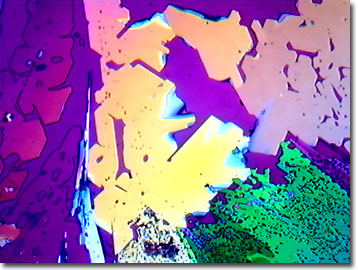Polarized Light Digital Image Gallery
Silver Bromide
Historically used in photography, silver bromide crystals are finding new life in very deep infrared applications as windows and lenses, particularly when sensitivity to moisture is an issue. Under heat and pressure, the soft silver bromide crystal deforms and can be forged against polished dies to create optical elements.

Known also as bromoyrite, silver bromide (AgBr) boils at 1,300 degrees Celsius, melts at 42 degrees Celsius, and is insoluble in water. It forms a pale yellow powder that has no odor, a molecular weight of 187.78, and crystals that do not cleave. On the commercial scale, silver bromide emulsions are created from the addition of silver nitrate to solutions of potassium bromide and gelatin, with about 25 to 40 percent of the industrial silver supply consumed in the production of photosensitive emulsions. Caution is needed if the compound is heated since at decomposition, toxic fumes of bromine gas may be released. Whether ingested or taken in through respiration, inorganic bromides, such as silver bromide, produce depression, emaciation, and in severe cases, psychosis. Resembling acne, bromide rashes (especially on the face), occur if silver bromide is inhaled. With chronic exposure, kidney damage and bronchitis will also develop. Argyreia, a grayish pigmentation symptom from concentrating silver particles in the skin, eyes, and other tissues, occurs from chronic exposure.
Photographic emulsions are made of fine grains of silver bromide suspended in a thin layer of gelatin. When negative film is processed, the developer converts light-sensitive crystallites of silver bromide in the emulsion layers into metallic silver. At the atomic level, a photon hits the silver bromide crystal and frees an electron from the bromide ion. The liberated electron moves around the crystal, eventually lodging in the crystal lattice defects, turning silver ions into silver atoms. Slowly, as this process continues, tiny specks of elemental silver start to appear in the crystal lattice, darkening its surface from the inherent yellow color. A similar photochemical decomposition process occurs if the crystals are composed of silver chloride. A photo fixative solution containing thiosulfate ions removes undeveloped grains of silver bromide from the negative and creates a soluble silver thiosulfate complex, leaving a negative that retains the silver image after bathing.
Referred to as negatives, the darkest areas (most elemental silver) of the developed film correspond to portions exposed to the most light. A positive print is made by exposing print paper also coated with a silver halide emulsion to light, which passes through the superimposed negative. The exposed print paper is then developed and fixed. Around 1900, before the advent of color photography, "silver prints" based on silver bromide constituted high quality black and white photography. In radiography, after exposure to X-rays, an image is developed by treating the emulsion film with a solution of alkali and metol (a developer), where the alkali penetrates the protective coating of gelatin and then the metol reduces the exposed silver bromide to black metallic oxide before it is fixed.
With a wide transmission range (0.45 to 35 microns) and a very high refractive index of 2.31 (at 0.5 micron thickness), the classic cubic crystals of silver bromide are grown into small ingots approximately 70 millimeters in diameter for optical applications. The salt is often manufactured as a thin, rolled sheet available for custom cutting and shaping, and can be polished with a cotton cloth. Silver bromide darkens less readily than silver chloride when exposed to sunlight and it is also malleable. The orientation of silver bromide is accomplished using X-rays, etching, or epitaxial growth of sodium chloride. Powdery silver bromide can be utilized as a polishing agent.
Contributing Authors
Omar Alvarado, Thomas J. Fellers and Michael W. Davidson - National High Magnetic Field Laboratory, 1800 East Paul Dirac Dr., The Florida State University, Tallahassee, Florida, 32310.
BACK TO THE POLARIZED LIGHT IMAGE GALLERY
BACK TO THE DIGITAL IMAGE GALLERIES
Questions or comments? Send us an email.
© 1995-2025 by Michael W. Davidson and The Florida State University. All Rights Reserved. No images, graphics, software, scripts, or applets may be reproduced or used in any manner without permission from the copyright holders. Use of this website means you agree to all of the Legal Terms and Conditions set forth by the owners.
This website is maintained by our
Graphics & Web Programming Team
in collaboration with Optical Microscopy at the
National High Magnetic Field Laboratory.
Last Modification Friday, Nov 13, 2015 at 01:19 PM
Access Count Since September 17, 2002: 24307
Visit the website of our partner in introductory microscopy education:
|
|
